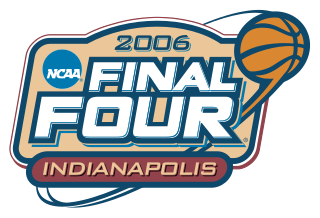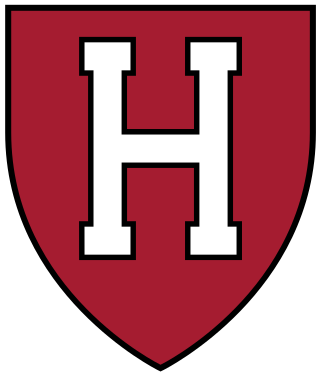Related Research Articles

The 2006 NCAA Division I men's basketball tournament involved 65 teams playing in a single-elimination tournament to determine the national champion of men's NCAA Division I college basketball as a culmination of the 2005–06 basketball season. It began on March 14, 2006, and concluded with the championship game on April 3 at the RCA Dome in Indianapolis, Indiana.
This is a list of qualifying teams in the 2007 NCAA Division I men's basketball tournament. A total of 65 teams entered the tournament. Thirty of the teams earned automatic bids by winning their conference tournaments. The automatic bid of the Ivy League, which did not conduct a postseason tournament, went to its regular season champion. The remaining 34 teams were granted at-large bids, which were extended by the NCAA Selection Committee. All teams were seeded within their assigned region from 1 to 16, which was disclosed, while the Selection Committee seeded the entire field from 1 to 65, which was not disclosed.

The 1999–2000 NCAA Division I men's basketball season began on November 11, 1999, with the Coaches vs. Cancer Classic, progressed through the regular season and conference tournaments, and concluded with the 2000 NCAA Division I men's basketball tournament championship game on April 3, 2000, at the RCA Dome in Indianapolis, Indiana.

The 2005–06 NCAA Division I men's basketball season began on November 6, 2005, progressed through the regular season and conference tournaments and concluded with the 2006 NCAA Division I men's basketball tournament championship game on April 3, 2006, at the RCA Dome in Indianapolis, Indiana. The Florida Gators won their first NCAA national championship with a 73–56 victory over the UCLA Bruins. This was the last Final Four site at the RCA Dome. The Final Four will return to the city of Indianapolis, but will be held at Lucas Oil Stadium.

The 2004–05 NCAA Division I men's basketball season began on November 10, 2004, progressed through the regular season and conference tournaments, and concluded with the 2005 NCAA Division I men's basketball tournament championship game on April 4, 2005, at the Edward Jones Dome in Saint Louis, Missouri. The North Carolina Tar Heels won their fourth NCAA national championship with a 75–70 victory over the Illinois Fighting Illini.
This is a list of qualifying teams for the 2009 NCAA Division I men's basketball tournament. A total of 65 teams entered the tournament. Thirty of the teams earned automatic bids by winning their conference tournaments. The automatic bid of the Ivy League, which did not conduct a postseason tournament, went to its regular season champion. The remaining 34 teams were granted at-large bids, which were extended by the NCAA Selection Committee. All teams were seeded within their assigned region from 1 to 16, which was disclosed, while the Selection Committee seeded the entire field from 1 to 65, which was not disclosed.
This is a list of qualifying teams for the 2010 NCAA Division I men's basketball tournament. A total of 65 teams entered the tournament. Thirty of the teams earned automatic bids by winning their conference tournaments. The automatic bid of the Ivy League, which did not conduct a postseason tournament, went to its regular season champion. The remaining 34 teams were granted at-large bids, which were extended by the NCAA Selection Committee. All teams were seeded within their assigned region from 1 to 16, which was disclosed, while the Selection Committee seeded the entire field from 1 to 65, which was not disclosed.
The 2010–11 Princeton Tigers men's basketball team represented Princeton University in intercollegiate college basketball during the 2010–11 NCAA Division I men's basketball season. The head coach was Sydney Johnson, who was in his fourth season. The team's tri-captains were senior Kareem Maddox, senior Dan Mavraides, and junior Patrick Saunders. The team played its home games in the Jadwin Gymnasium on the University campus in Princeton, New Jersey. The team competes in the Ivy League athletic conference. The team was coming off of a 22–9 2009–10 season in which it achieved the most wins by a Tigers men's basketball team since the 1998–99 team and its first back-to-back finishes of at least second place in the Ivy since 2001–02 season. The team was also following on the heels of its first postseason appearance since the 2003–04 team went to the 2004 NCAA Division I men's basketball tournament, and its first postseason victory since the 1998–99 team won two games in the 1999 National Invitation Tournament.
This is a list of qualifying teams for the 2011 NCAA Division I men's basketball tournament. A total of 68 teams entered the tournament, an increase of three from the prior season with introduction of the opening round "First Four". Thirty of the teams earned automatic bids by winning their conference tournaments. The automatic bid of the Ivy League, which did not conduct a postseason tournament, went to its regular season champion. The remaining 37 teams were granted at-large bids, which were extended by the NCAA Selection Committee. All teams were seeded within their assigned region from 1 to 16, which was disclosed, while the Selection Committee seeded the entire field from 1 to 68, which was not disclosed.
This is a list of qualifying teams for the 2012 NCAA Division I men's basketball tournament. A total of 68 teams entered the tournament. Thirty of the teams earned automatic bids by winning their conference tournaments. The automatic bid of the Ivy League, which did not conduct a postseason tournament, went to its regular season champion. The remaining 37 teams were granted at-large bids, which were extended by the NCAA Selection Committee. All teams were seeded 1 to 16 within their regionals, while the Selection Committee seeded the entire field from 1 to 68. For the first time ever, the Selection Committee disclosed each team's seed within the entire field following the announcement of the entire bracket.

The 2012–13 Harvard Crimson men's basketball team represented Harvard University during the 2012–13 NCAA Division I men's basketball season. The Crimson, led by sixth year head coach Tommy Amaker, played their home games at Lavietes Pavilion and are members of the Ivy League.

The 2012 NCAA Division I women's volleyball tournament started on November 29, 2012, and ended on December 15 at the KFC Yum! Center in Louisville, Kentucky with Texas winning the national championship. The NCAA selection show was televised on Sunday, November 25, 2012.
This is a list of qualifying teams in the 2001 NCAA Division I men's basketball tournament. A total of 65 teams entered the tournament. Twenty-nine of the teams earned automatic bids by winning their conference tournaments. The automatic bids of the Ivy League and Pacific-10, which did not conduct a postseason tournament, went to their regular season champion. The remaining 34 teams were granted at-large bids, which were extended by the NCAA Selection Committee. All teams were seeded within their assigned region from 1 to 16, which was disclosed, while the Selection Committee seeded the entire field from 1 to 65, which was not disclosed.
This is a list of qualifying teams for the 2015 NCAA Division I men's basketball tournament. A total of 68 teams entered the tournament. Thirty-one of the teams earned automatic bids by winning their conference tournaments. The automatic bid of the Ivy League, which did not conduct a postseason tournament, went to its regular season champion. The remaining 36 teams were granted at-large bids, which were extended by the NCAA Selection Committee. All teams were seeded 1 to 16 within their regionals, while the Selection Committee seeded the entire field from 1 to 68.
This is a list of qualifying teams in the 2006 NCAA Division I men's basketball tournament. A total of 65 teams entered the tournament. Thirty of the teams earned automatic bids by winning their conference tournaments. The automatic bid of the Ivy League, which did not conduct a postseason tournament, went to its regular season champion. The remaining 34 teams were granted at-large bids, which were extended by the NCAA Selection Committee. All teams were seeded within their assigned region from 1 to 16, which was disclosed, while the Selection Committee seeded the entire field from 1 to 65, which was not disclosed.
This is a list of qualifying teams in the 2005 NCAA Division I men's basketball tournament. A total of 65 teams entered the tournament. Thirty of the teams earned automatic bids by winning their conference tournaments. The automatic bid of the Ivy League, which did not conduct a postseason tournament, went to its regular season champion. The remaining 34 teams were granted at-large bids, which were extended by the NCAA Selection Committee. All teams were seeded within their assigned region from 1 to 16, which was disclosed, while the Selection Committee seeded the entire field from 1 to 65, which was not disclosed.
This is a list of qualifying teams in the 2004 NCAA Division I men's basketball tournament. A total of 65 teams entered the tournament. Thirty of the teams earned automatic bids by winning their conference tournaments. The automatic bid of the Ivy League, which did not conduct a postseason tournament, went to its regular season champion. The remaining 34 teams were granted at-large bids, which were extended by the NCAA Selection Committee. All teams were seeded within their assigned region from 1 to 16, which was disclosed, while the Selection Committee seeded the entire field from 1 to 65, which was not disclosed.
This is a list of qualifying teams in the 2002 NCAA Division I men's basketball tournament. A total of 65 teams entered the tournament. Thirty of the teams earned automatic bids by winning their conference tournaments. The automatic bid of the Ivy League, which did not conduct a postseason tournament, went to its regular season champion. The remaining 34 teams were granted at-large bids, which were extended by the NCAA Selection Committee. All teams were seeded within their assigned region from 1 to 16, which was disclosed, while the Selection Committee seeded the entire field from 1 to 65, which was not disclosed.
This is a list of qualifying teams in the 2000 NCAA Division I men's basketball tournament. A total of 64 teams entered the tournament. Twenty-nine of the teams earned automatic bids by winning their conference tournaments. The automatic bids of the Ivy League and Pacific-10, which did not conduct a postseason tournament, went to their regular season champion. The remaining 33 teams were granted at-large bids, which were extended by the NCAA Selection Committee. All teams were seeded within their assigned region from 1 to 16, which was disclosed, while the Selection Committee seeded the entire field from 1 to 64, which was not disclosed.
This is a list of qualifying teams in the 1999 NCAA Division I men's basketball tournament. A total of 64 teams entered the tournament. Twenty-nine of the teams earned automatic bids by winning their conference tournaments. The automatic bids of the Ivy League and Pacific-10, which did not conduct a postseason tournament, went to their regular season champion. The remaining 33 teams were granted at-large bids, which were extended by the NCAA Selection Committee. All teams were seeded within their assigned region from 1 to 16, which was disclosed, while the Selection Committee seeded the entire field from 1 to 64, which was not disclosed.
References
- ↑ "2003 NCAA tournament: Bracket, scores, stats, rounds". NCAA.com. May 8, 2020. Retrieved May 25, 2022.
- ↑ "2008–09 Atlantic Coast Conference Men's Basketball Media Guide". Atlantic Coast Conference. 2008. p. 109. Archived from the original on January 1, 2011. Retrieved May 25, 2022.
- ↑ "2021-22 Big South Basketball Media Guide" (PDF). BigSouthSports.com. Retrieved May 25, 2022.
- ↑ "Men's Basketball Championship History". MAACSports.com. Retrieved May 25, 2022.
- ↑ "MEAC Men's Basketball 2019–2020 Record Book" (PDF). Mid-Eastern Athletic Conference . Retrieved May 25, 2022.
- ↑ "2021-22 Men's Basketball Media Guide" (PDF). OVCSports.com. Retrieved May 25, 2022.